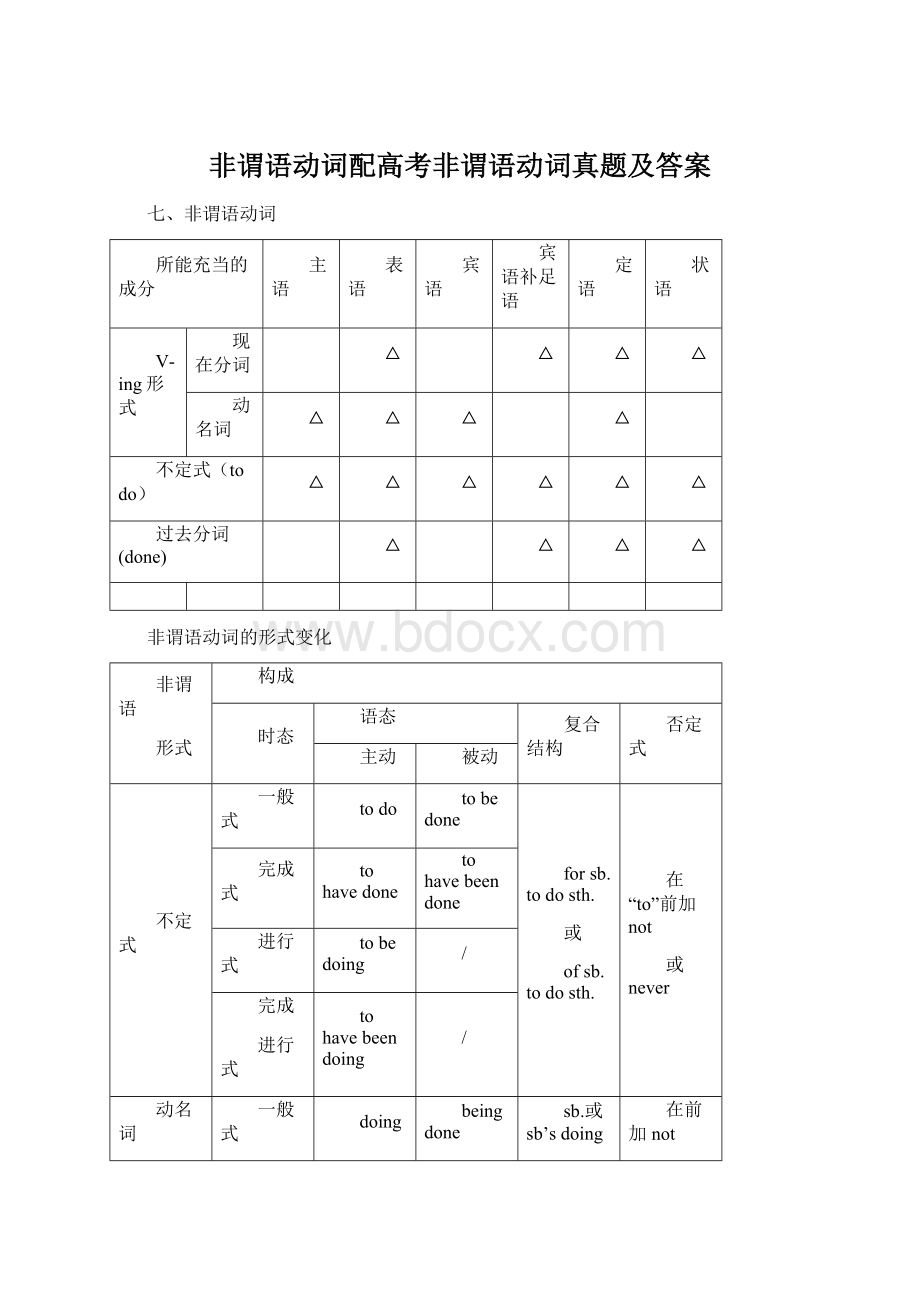非谓语动词配高考非谓语动词真题及答案Word文件下载.docx
《非谓语动词配高考非谓语动词真题及答案Word文件下载.docx》由会员分享,可在线阅读,更多相关《非谓语动词配高考非谓语动词真题及答案Word文件下载.docx(10页珍藏版)》请在冰豆网上搜索。

ofsb.todosth.
在“to”前加not
或never
完成式
tohavedone
tohavebeendone
进行式
tobedoing
/
完成
tohavebeendoing
doing
beingdone
sb.或sb’sdoing
作主语要用
sb’sdoing
在前加not
特别注意复合结构的否定式:
sb’snotdoing
sb’snothavingdone
havingdone
havingbeendone
与动名词变化形式相同
在解非谓语习题时同学们遇到最大的困难有两个:
一是如何判别是谓语动词还是非谓语动词;
二是如何选用哪一种非谓语动词及其恰当的形式。
非谓语语法功能的比较
做宾语的非谓语动词比较
情况
常用动词
只接不定式
做宾语的动词
hope,want,offer,long,fail,expect,wish,ask,decide,pretend,manage,agree,afford,determine,promise,happen
只接动名词
做宾语的动词或短语
mind,miss,enjoy,imagine,practise,suggest,finish,escape,excuse,appreciate,admit,prevent,keep,dislike,avoid,risk,resist
feellike,succeedin,befondof,objectto,getdownto,beengagedin,insiston,thinkof,beproudof,takepridein,setabout,beafraidof,betiredof,lookforwardto,devoteoneselfto,beworth,bebusy,payattentionto,stickto
两者都可以
意义基本相同
begin,start,like,love,hate,prefer,continue(接不定式多指具体的动作,接动名词多指一般或习惯行为)
need,want,require(主语与动名词之间存在逻辑上的动宾关系,接动名词主动形式表示被动意义,若接不定式则应用被动形式)
意义相反
stoptodo停止手中所做的事,去做另一件事
stopdoing停止正在做的事
意义不同
remember/forget/regrettodo(指动作尚未发生)
remember/forget/regretdoing(指动作已经发生)
goontodo(接着做另外一件事)
goondoing(接着做同一件事)
trytodo(设法,努力去做,尽力)
trydoing(试试去做,看有何结果)
meantodo(打算做,企图做)
meandoing(意思是,意味着)
can’thelp(to)do(不能帮忙做)
can’thelpdoing(忍不住要做)
beconsideredtohavedone被认为已经做了
consider…tobe认为是
considerdoing考虑做某事
做宾补的非谓语动词比较
分类
常见动词
与宾语的逻辑关系及时间概念
例句
ask,beg,expect,get,order,tell,want,wish,encourage
主谓关系,强调动作将发生或已经完成
Iaskedtobesenttothecountryside.
Iheardhimcallmeseveraltimes.
have,notice,see,watch,hear,feel,let,make
notice,see,watch,hear,find,keep,have,feel
主谓关系,强调动作正在进行,尚未完成
Ifoundherlisteningtotheradio.
过去分词
动宾关系,动作已经完成,多强调状态
Wefoundthevillagegreatlychanged.
做定语的非谓语动词比较
区别
与被修饰词往往有动宾关系,一般式表示将来,进行式表示与谓语动作同时发生,完成式表示在谓语动词之前发生
Ihavealotofpaperstotype.
Ihavealotofpaperstobetyped.
Ihaven’tdecidedwhichhoteltostayat.(介词at不能丢)
通常指被修饰词的用途,无逻辑上的主谓关系
Shallwegototheswimmingpool?
与被修饰词之间是主谓关系,表示动作与谓语动作同时发生
theboilingwater/theboiledwater
thedevelopingcountry/thedevelopedcountry
thefallingleaves/thefallenleaves
与被修饰词之间是被动关系,表示动作发生在谓语动作之前,现已经完成或只表示状态
注意:
thebridgetobebuilt将建造的桥,thebridgebeingbuilt正在建造的桥,thebridgebuilt已经建好的桥
非谓语动词高考考点
【考点一】不定式作状语
不定式作状语时相当于一个状语从句,不定式作状语时往往用来作目的状语、结果状语或原因状语。
1.不定式用来作目的状语:
作目的状语时,不定式的逻辑主语通常也是全句的主语,这里往往译作“为了,想要”。
Tobeawinner,youneedtogiveallyouhaveandtryyourbest.要想成为赢家,你要付出所有并竭尽全力。
2.不定式用于so...asto...,such...asto;
enoughto;
too...to;
onlyto等结构中作结果状语。
Wouldyoubesokindastolendmeyourbicycle?
你能不能行行好,借给我你的自行车?
Heissuchafoolastothinkthathisstrangebehaviourcaninflectothers.他如此愚蠢以至于认为他奇怪的行为会影响他人。
Hehurriedtothebookingofficeonlytohavebeentoldalltheticketshadbeensoldout.
他匆忙去了售票处,结果被告诉所有的票已经卖完了。
专家提醒:
“only+todo”表示出乎意料的结果,tell和主语He之间存在动宾关系,因而应用不定式的被动结构。
而现在分词作结果状语则表示自然而然的结果。
Hisparentsdied,leavinghimanorphan.
他的父母去世了,使他成为孤儿。
【经典考题】
1.Thereweremanytalentedactorsouttherejustwaiting________.
A.todiscover
B.tobediscovered
C.discovered
D.beingdiscovered
2.—Whyarethestudentsworkingsohardthesedays.
—________readyforthecomingentranceexamination.
A.Toget
B.Get
C.Getting
D.Got
3.WithFather’sDayaroundthecorner,Ihavetakensomemoneyoutofthebank________presentsformydad.
A.buy
B.tobuy
C.buying
D.tohavebought
【考点二】过去分词作状语
1.过去分词作状语和现在分词作状语一样,修饰主句的谓语动词,意义上相当于状语从句,表示时间、原因、条件、伴随状况等。
Giventherightkindoftraining,theseteenagersoccerplayersmayonedaygrowintointernationalstars.
如果得到正确的训练,这些少年足球选手有朝一日可能成为国际明星。
Remindednottomisstheflightat15∶20,themanagersetoutfortheairportinahurry.
得到提醒不要错过15∶20的航班,他匆忙出发过了机场。
2.某些动词的过去分词已经形容词化,且往往用于一些系表结构中。
此时这些过去分词既不表示被动,也不表示完成,而表示一种状态,这样的词有:
lost(迷路的),seated(坐),hidden(躲),lost/absorbedin(沉溺于),dressedin(穿着),tiredof(感到厌倦)等,不管它们作什么成分都不用其ing形式。
Lostinthemountainsforaweek,wewerefinallysavedbythelocalpolice.在大山里迷失一个星期,我们最终被当地警察所救。
Absorbedinhisbook,hedidn’tnoticemeentertheroom.
专心读书,他没注意到我进入房间。
1.________fromthetopofthetower,thesouthfootofthemountainisaseaoftrees.
A.Seen
B.Seeing
C.Havingseen
D.Tosee
2.Michael’snewhouseislikeahugepalace,________withhisoldone.
A.comparing
B.compares
C.tocompare
D.compared
【考点三】现在分词作状语
1.动词的ing短语作状语表示在进行一动作的同时所进行的另一动作,它对谓语动词起修饰和陪衬的作用。
动词的ing形式作状语可以表示时间、原因、条件、让步、结果、方式或伴随情况。
Beingill,hecouldn’tgotoschool.
因为生病,他不能去上学。
(原因)
Mycarwascaughtinatrafficjam,thuscausingthedelay.
我的车被交通拥挤堵住,所以延误了。
(结果)
Asthelightturnedgreen,Istoodforamoment,notmoving,andaskedmyselfwhatIwasgoingtodo.(伴随)
当交通路灯变绿灯时,我站了一会儿,一动不动,自问要做什么事。
2.现在分词有:
一般式、被动式、完成式和完成被动式四种形式,每一种形式的否定式都是直接在前面加not构成。
一般式(doing)表示主动的一般性的动作或者正在进行的动作;
被动式(beingdone)表示正在进行的被动的动作;
完成式(havingdone)表示发生在谓语动作之前的主动的动作;
完成被动式(havingbeingdone)表示发生在谓语动作之前的被动的动作。
Nothavingreceivedareply,hedecidedtowriteagain.
没有得到答复,他决定再写信去。
Theoldman,havingworkedabroadfortwentyyears,camebacktohismotherland.(work与句子的主语Theoldman之间存在主谓关系,而且work这一动作发生在谓语动作之前)
在国外工作了二十年,这位老人回到了祖国。
Havingbeenscoldedmanytimes,hedeterminedtostudyhardtocatchupwithothers.
多次被批评之后,他决定努力学习赶上他人。
3.有一些固定结构,如:
generallyspeaking,takingeverythingintoconsideration,judgingfrom/by等,无论主语是什么都用这种形式作状语。
Takingeverythingintoconsideration,theresultisbetterthanexpected.
把一切因素考虑进去,结果比预料的要好。
Judgingfromwhathesaid,hemustbeanhonestman.
从他说的话来判断,他一定是一位诚实的人。
4.现在分词和过去分词作状语的区别:
如果是意义上的主谓关系,一般用现在分词形式;
如果是意义上的动宾关系,则一般用过去分词。
Seenfromthetopofthehill,theparklooksevenmorebeautiful.从山顶上看,这个公园显得更加美丽。
(see与主语thepark之间存在动宾关系)
Seeingfromthetopofthehill,wefindtheparkevenmorebeautiful.
从山顶上看,我们发现这个公园显得更加美丽。
(see与主语we之间存在主谓关系)
1.Dina,________formonthstofindajobasawaitress,finallytookapositionatalocaladvertisingagency.
A.struggling
B.struggled
C.havingstruggled
D.tostruggle
2.________atmyclassmates’faces,Ireadthesameexcitementintheireyes.
A.Looking
B.Look
C.Tolook
D.Looked
3.________awrittenpermission,hehadtowriteanotherlettertothepresidentoftheuniversity.
A.Notgiving
B.Nothavingbeengiven
C.Havingnotgiven
D.Havingnotbeengiven
【考点四】非谓语动词作定语
1.现在分词(短语)作定语与所修饰的名词之间存在着逻辑上的主谓关系,表示该动作的主动和进行。
Therearetworoadsbeforeus,oneleadingtothebeach,theothertothepark.
在我们面前有两条路,一条通向沙滩,另一条通向公园。
2.过去分词(短语)作定语与它所修饰的名词在逻辑上有被动关系,表示该动作的被动或完成。
Forbreakfastheonlydrinksjuicefromfreshfruitgrownonhisownfarm.
早饭他只喝自己农场种植的新鲜水果榨出来的果汁。
3.动词不定式作定语多表示将来动作。
WeareinvitedtoapartytobeheldinourclubnextFriday.
我们被邀请参加下周五在我们俱乐部举行的聚会。
1.I’mafraidwe’llhavetoworkextrahours,fortherearestillsomeproblems________.
A.remainingtosettle
B.remainingtobesettled
C.remainedtotalkabout
D.toremaintodiscuss
2.Manybuildingsinthecityneedrepairing,buttheone________firstisthelibrary.
A.repaired
B.beingrepaired
C.repairing
D.toberepaired
【考点五】非谓语动词作宾补
1.过去分词作宾语补足语:
过去分词作宾语补足语时,句中的宾语往往就是其逻辑主语,该动词与宾语之间存在动宾关系。
I’llhavemyhousepaintedtomorrow.
明天我会让人把我的房子粉刷一下。
(被动)
WhenIopenedthedoor,Ifoundthegroundcoveredbyfallenleaves.
当我打开门时,我发现地面被落叶所覆盖。
2.现在分词作宾语补足语:
现在分词作宾语补足语时,句中的宾语往往就是其逻辑主语,该动词与宾语之间存在主谓关系。
现在分词作宾语补足语强调正在进行的主动动作,即动作过程的一个部分。
可以带有这种复合宾语的动词有see,watch,hear,observe,feel,find,have,keep等。
Theyusecomputerstokeepthetrafficrunningsmoothly.他们使用电脑使交通畅通无阻。
1.Listen!
Doyouhearsomeone________forhelp?
A.calling
B.callC.tocall
D.called
2.Alexandertriedtogethiswork________inthemedicalcircles.
A.torecognize
B.recognizing
C.recognize
D.recognized
3.It’swonderfultohikewithDadandIhavefelt________withhim.
A.toprotected
B.protected
C.protecting
D.tobeprotected
【考点六】have,get后接三种形式作宾补
have,get后接三种形式作宾补时,其中have,get表示“使、让、叫”之意。
1.havesth.done=getsth.done使/让某事由别人去做(叫/让某人做某事)
I’llhave/getmybikerepairedtomorrow.
我明天得(请人)修一下我的自行车。
MrSmithhadhishousebrokenintowhilehewasawayonholiday.
2.have/getsb./sth.doing使某人/物持续做某事
havesb.doing若用于否定句中,其中have有“容忍”之意。
Iwon’thaveyouspeakingtoyourdadlikethat.
我不允许你和你父亲那样讲话。
3.havesb.dosth.叫某人做某事
1.Ihavealotofreadings________beforetheendofthisterm.
A.completing
B.tocomplete
C.completed
D.beingcompleted
2.Withtheworldchangingfast,wehavesomethingnew________withallbyourselveseveryday.
A.deal
B.dealt
C.todeal
D.dealing
3.Everyyear,Tomrememberstohavesomeflowers________tohermotheronherbirthday.
A.send
B.sent
C.sending
D.beingsent
1.Thenextthinghesawwassmoke__________frombehindthehouse.
A.roseB.risingC.toriseD.risen
2.Theisland,__________tothemainlandbyabridge,iseasytogoto.
A.joiningB.tojoinC.joinedD.havingjoined
3.Sarahpretendedtobecheerful,_________nothingabouttheargument.
A.